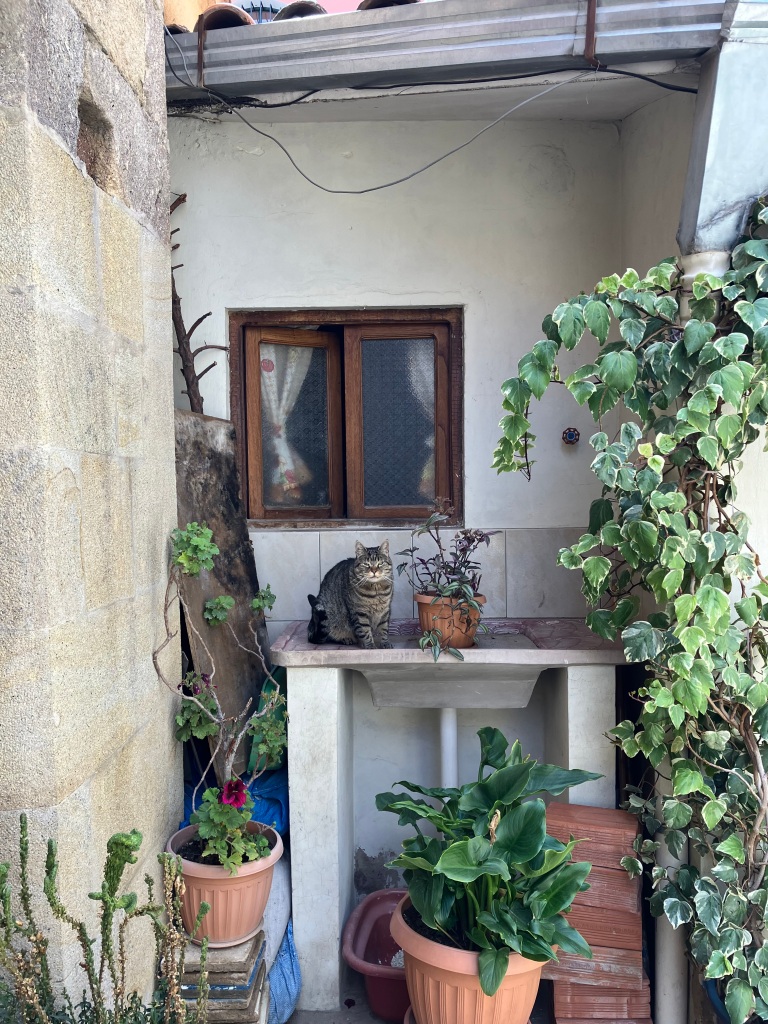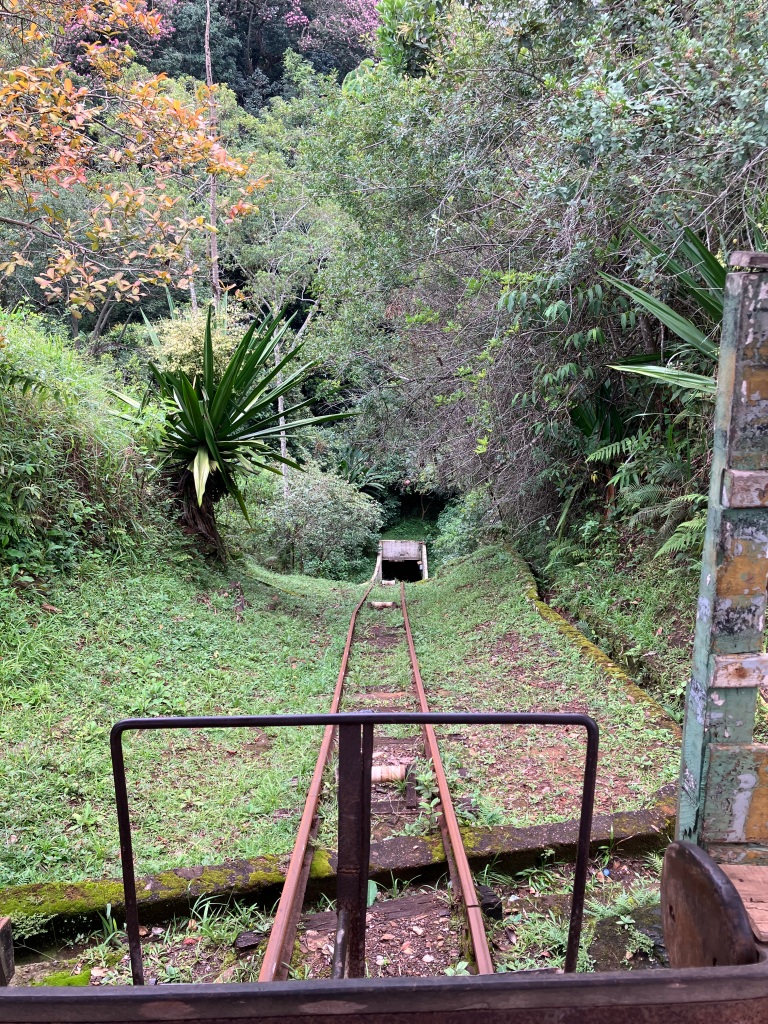None were as cool as the accidental archive cat in Sucre, of course.





None were as cool as the accidental archive cat in Sucre, of course.





My biggest disappointment on this trip so far has been visiting a mine in Mariana, Minas Gerais, in Brazil. According to Brazil with Michael Palin, there’s a shrine to St Barbara in a mine in Minas Gerais. This mine, however, was not mentioned in any of the literature on miners’ religious practices. After going to several mines I realized where the documentary was filmed. I had already planned to visit the Mina de Passagem, and so one morning I took the bus for a visit.
Now, as an aside: when I travel I prefer to keep all my transportation options to subways/light rail because there are only so many places a train can go. If they are diverted, they still end up somewhere recognizable. Nowhere I visited in Minas Gerais (outside of the capitol, Belo Horizonte), has rail. So I took local and intercity buses. This is always a nerve-wracking experience – even though many bus routes are on the Moovit app – I never knew how much to pay, where the bus stops were, or if you could hail a bus when the bus stop is not clear. The inter-city buses, which I took to the mine and to the archive I mention in this article had a separate person to collect money and give change so at least my confusion with Brazilian transportation and currency was not slowing down other people too much.
I took a tour and when we arrived at the shrine, the guide said it was put there for tourists. I speak very rudimentary Portuguese but the guide elaborated, and said a lot of movies and telenovelas have been filmed there so I knew it was the right place. The documentary lied to me! That being said this mine had a shrine in it, which was interesting, and something does not have to be historically accurate to be worth investigating. If it did, I would have written far fewer articles and books and so would many other people.


I also went to the archive at the Archdiocesan archive in Mariana, and looked at some documents, and the Casa dos Contos museum in Ouro Preto, to look at some more. The latter was more fruitful because I could take pictures and use my computer to take notes. My handwriting skills have really deteriorated so I can’t do it for that long.

By far my favourite place to do research so far has been in the Archdiocesan archive in Diamantina, where I went after I left Ouro Preto. The archivist was actually a lawyer so I was skeptical but she explained that she had taken some additional workshops or courses and over the past couple of years had inventoried the majority of the collection, so when I explained my project she was really helpful! I also sadly could not take pictures of documents there but the other person in the archive was using his computer so I asked if I could use mine too, and thankfully I could. That is a place I would like to go back to to learn more about life in a mining region.

In my previous post, I mentioned that I did not manage to sort out all the details of my project while in Mexico City. This is on track for every other research project I have conducted. Alas.
I did manage to do five important research-related things.
Research Talk and Book Fair Shortly after I arrived in my beloved Mexico City, I was invited to speak in an “open class” at the Universidad Iberoamericana, a Jesuit University in Mexico City. While I was there, speaking about my most recent book on human rights and law and literature, I got to talk to a few faculty members and go to a mini book fair (thanks especially to M for the invitation). Book fairs are important because it is often one of the only ways to buy new books published in Mexico by Mexican university or publicly affiliated presses. I was really happy to be able to buy some books about San Luis Potosí from the Universidad Iberoamericana’s press and the Colegio de San Luis’ press.

Book extravaganza On a Saturday morning, T, someone I’d met a long time ago, and her husband, F, invited me and other people interested in Mexican literature to select books from their personal collection – they were moving and found that they had too many books to move comfortably. I found all kinds of interesting things about Mexican literature, art and culture.
Ibero library and Archives I also returned to the Ibero somewhat later in my trip to use the library and archives. I was first taken there some years ago by some friends (R and M), and it has really great collections on feminism from the 1970s. It also has a bunch of documents from Porfirio Díaz, the Mexican president who invited Mormons to come to Mexico (per friend K). It was really cool to get to see letters from him! It also has a more recent less-well-inventories collection of photographs by Mariana Yampolsky, including many of the region in and around Real de Catorce, which was relevant to my project. I also was able to speak a bit more with some other colleagues, meet a fellow Canadian (who is a professor there) and learn that some right-leaning Catholic lay organizations opposed mining in the region I’m interested in studying (left-leaning Catholic lay organizations also oppose mining and primary resource extraction in other regions of Mexico, such as Chiapas and Oaxaca).

UNAM libraries The UNAM also has many, many libraries. Thankfully most of the books I wanted to read were in the same general area of the campus and so I could read some books that I could no longer purchase. I also was able to use the bibliographies of these books to find more articles about my subject area – published by Mexican scholars, which is important to me because I want to ensure that my research – even though it’s in English – is in dialogue with Mexican scholars on the same topics.
Archivo General de la Nación Thanks to historian Linda Arnold, most of the archive database is available online, and even though sometimes archive staff say the codes are out of date, they usually aren’t (this is much the same process as it was in 2015/2016, when I last did significant research in the AGN). I read some documents on mining, and looked at some migration documents about people who emigrated to San Luis Potosí for mining.

Secret Police Files And then, thanks to a historian colleague S at the University of Vermont, I was able to search the secret police files. I decided to search them for any instance of the word Mennonite or Mormon and used a few typical last names in both communities. I did not find anything about Mormons but I think that is more a product of the incomplete inventory of this part of the collection – the secret police kept reports on everyone. I was finally able to read the documents about a Mennonite thought to be a Nazi (I had tried to access this document before but it was unavailable for researchers) but it was only one page long and just said he wasn’t one. I also found out more about 1970s land disputes between ejidos and Mennonites in Zacatecas – something that I still don’t think I have right even though I wrote about it in my book about Mennonites and Mormons in Mexico and in an open-access article that expands on the chapter on land reform and Mennonites in the book. I also learned about a time when a young Mennonite man was kidnapped as part of or in the midst of 1970s activism in Chihuahua – for those interested in Mennonite history in Mexico I believe he was the son of prominent Russländer Mennonite Aaron Redekop – and I’d like to write more about that.
I thought I wasn’t going to research Mennonites or Mormons anymore but I was really, really wrong. I also was afraid my books would not fit in my bags on the way back but I had brought an extra backpack for books and the Mexican laundromat by my airbnb magically made my clothes like a quarter of the size once they were washed and folded, so it worked.
Hello and welcome back to my blog after a many year hiatus. I am on sabbatical this year and so am once again traveling. I’m researching religious sites in or near mines and asking what these churches (primarily) are doing for the mine workers – how do they offer ways mine workers (who are often immigrants or migrants from another part of the same country) community, a sense of transcendence, or solidarity in the union sense? Do they offer others around a mining operation a sense of safety from explosions or environmental devastation?
My academic travels are starting at the Hagley library. I am living in a museum, ie living my dream! It is at the site of the former DuPont gunpowder factory. The home where I’m staying is right across the road from a Sunday school for worker children, which came out of the First Great Awakening in the United States, and the idea that children needed some kind of education.

The museum is somewhat isolated – I saw a deer from my bedroom window the other day. For those concerned about my safety there are many people around during the day, and maintenance staff, the director, and other scholars are all on site.

In the mornings I make my way from the former company town to the archives – in a place that once stored or manufactured something to do with sodium – or the library. I have enjoyed its approach to archives, which is quite different from archives in Mexico. I can make an appointment, request everything ahead of time and then there are carts with my name on them! There is no daily maximum of files, and there is sufficient staff that grad students and professors can do research peacefully – and members of the public can get the attention they need if they are not very familiar with archival processes.

So far the most interesting files I’ve read have been about how DuPont collaborated with progress in Mexico, information about DuPont company towns, and the relationship between Catholicism and Irish radicalism in the US (ie the Molly Maguires). Who knows what I’ll find next week!